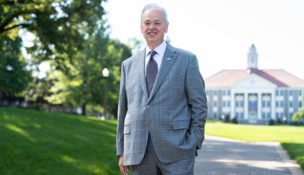The ‘iron triangle’
U.Va. controversy points to conflicting choices at public universities
Gary Robertson //October 29, 2016//
The ‘iron triangle’
U.Va. controversy points to conflicting choices at public universities
Gary Robertson //October 29, 2016//
The governing boards of Virginia’s public colleges and universities can face a vexing choice.
Should they keep tuition low to make the school accessible to the public or build the university’s financial strength so that it can attract top faculty and build state-of-the-art facilities?
Peter Blake, director of the State Council of Higher Education for Virginia (SCHEV), says there’s a name for the challenge facing boards of visitors. “It’s what we describe as ‘the iron triangle of affordability, access and quality.’ As one one of those increases, the other decreases.
“If you increase access, it could impact on quality. Those are the trade-offs trustees make,” Blake says.
Perhaps the conundrum might be better understood in the context of two landmark actions in state higher education, one passed by the legislature in 2005 and the other, in 2011.
In 2005, Virginia profoundly changed its relationship with its public colleges and universities through the Restructuring Act. The law gave institutions greater autonomy in setting tuition and managing their finances during a period of wide swings in state funding for higher education.
Then, six years later, the legislature approved the Higher Education Opportunity Act, or “Top Jobs Act.” Its primary objective was awarding 100,000 additional degrees between 2011 and 2025, while increasing access and affordability.
The ripple effects of those two laws are being felt in nearly every aspect of college operations, in decisions about tuition, enrollment and finances.
In August, top officials of the University of Virginia were summoned to the state Capitol, in part to see whether U.Va. was upholding its end of the deal public universities had struck with the state.
U.Va., Virginia Tech, the College of William and Mary and Virginia Commonwealth University have been granted the greatest autonomy (Level 3) under the Restructuring Act in handling their finances and other aspects of governance.
On the hot seat
The money committees of the House of Delegates and the state Senate put U.Va. on the hot seat in reaction to accusations by Helen Dragas, a former rector, of the existence of a secret “slush fund.”
In an op-ed piece in The Washington Post, the Hampton Roads real estate developer said the university’s governing board created the $2.3 billion fund for “pet projects” instead of using the money to reduce tuition.
Dragas noted in her opinion piece that, since 2009, tuition at U.Va. has increased 74 percent. Tuition for students entering U.Va. in the 2009-10 school year was $7,496. In 2016-17, it was $13,060 for first-time students.
SCHEV officials, however, stress that the cost of going to college will vary because of multiple factors, including the incomes of students and their families.
Nationally, since 1990, the average tuition at public four-year public institutions has skyrocketed more than 160 percent, according to the the National Conference of State Legislatures.
Virginia’s four-year comprehensive colleges are now the sixth most-expensive public institutions in the nation, and its doctoral institutions are 12th most-expensive, according to SCHEV’s most recent tuition and fees report.
U.Va. says its $2.3 billion fund, which goes up or down depending on market conditions, is best characterized as a “strategic investment fund,” which can generate as much as $100 million annually to improve the university without the use of tuition or tax dollars.
In mid-September, the board approved $26 million from the fund for 13 projects that ranged from increased financial support for doctoral students to the acquisition of a suite of tools to help faculty and students pursue large-scale research opportunities.
It is not surprising that U.Va.’s fund became a political issue. In an era of high student debt, college tuition has become a focal point for many members of the state legislature.
A college education has become progressively less affordable for many Virginia families. State funding has been one of the culprits. As state support decreases, tuition almost invariably rises.
Virginia has a long-stated target goal of providing 67 percent of the cost of a student in public higher education, but it has missed the mark time and again.
In 2017, the state is expected to pay only 47 percent, while students (and their families) pay 53 percent, according to SCHEV.
The General Assembly had increased appropriations for higher education last year with the hope that tuition increases could be held to a minimum.
No ‘inquisition’
At the joint legislative hearing, Tommy Norment, the Republican majority leader of the state Senate, offered an assessment of what was to come for U.Va. officials.
“The tone of the presentations should be factual. [It] will not devolve into an inquisition,” he said.
Eric Sandridge, director of higher education in the office of the state Auditor of Public Accounts, swiftly threw cold water on accusations of mismanagement. “I didn’t see anything that would indicate a slush fund of any kind,” Sandridge says. “As far as hiding assets, there is none of that there.”
He added that there were no general funds or tuition income in the fund. Instead, it is a pool of money drawn from cash reserves, as well as investment gains that had accumulated over the years.
U.Va. President Teresa Sullivan told legislators that, besides making the best use of its financial resources, the university was keeping its bargain on moderating tuition increases and providing access to more Virginians.
She noted that U.Va. had reduced a previously announced tuition increase of 3 percent for continuing students to 1.5 percent, thanks to a higher appropriation from the state. (In-state freshmen at U.Va. pay varying tuitions depending on whether they take an option that will secure a guaranteed four-year tuition rate.)
According to the university, the state’s contribution of $144.7 million represents about 10 percent of the university’s academic division budget of $1.39 billion in fiscal 2016-17. Of the university’s total approved operating budget of $3.2 billion for all divisions, including the University of Virginia at Wise and the university’s medical center, the state money amounts to less than 5 percent.
More spots for Virginians?
On providing greater access at U.Va. to more Virginians — a sticking point with many legislators about Virginia’s elite public institutions — Sullivan said that as a result of an enrollment growth plan implemented in 2011 (as part of the “Top Jobs Act”) the university has awarded undergraduate degrees to an additional 938 state students in the past five years.
Under the growth plan, U.Va. expects to enroll 1,673 more undergraduates by the 2018-19 academic year, an increase of 11.9 percent from 2010-11. Of these, 1,171 (70 percent) will be Virginians.
By 2019, Sullivan says, the university, which now has a student body of nearly 22,000, would be awarding degrees to an additional 385 in-state students annually. (About a third of U. Va. students are from outside the state. However, in-state students represent 69.3 percent of this year’s entering class, exceeding existing enrollment goals.)
U.Va. officials say they are committed to maintaining excellence alongside access and affordability. The U.Va. board of visitors will hold a one-day, called meeting on Nov. 11 to discuss possible uses of the strategic investment fund. College affordability is expected to be on the agenda.
“U.Va.’s dual roles as a public university and as a state flagship should never be contradictory or mutually exclusive. U.Va. must be public and excellent, affordable and excellent, accessible to Virginians and excellent,” Sullivan asserted before the money committees.
Looking at other schools
Other public institutions also could find themselves under intense scrutiny by the legislature.
The money committees have asked SCHEV, in conjunction with state auditors, to examine how other institutions are managing their finances with additional autonomy.
The current pacts between the state and its public colleges and universities point to a big issue for former state Sen. Edd Houck. He served in the Senate for 28 years and helped guide the creation of the Restructuring Act.
“Historically, higher education in many ways has been a stepchild of state funding in the commonwealth, and it’s gotten worse and worse. K-12 has been at the head of the line,” Houck says.
Virginia’s constitution does not mandate state support for higher education. K-12, on the other hand, has had since 1999 a committed source of funding: profits from the state lottery. (A constitutional amendment confirming that commitment passed in 2000.)
In fiscal year 2016, those profits totaled $588 million, the best results in the lottery’s 28-year history.
Houck says, however, declining state support is not the only thing making colleges expensive. He also cited rising institutional spending.
“I have been resistant to tuition increases, because you have to give up some things,” he says. “Even during the most difficult days of the recession, college and university budgets were growing.”
Houck, a member of the University of Mary Washington’s board of visitors, emphasizes that he is in no way speaking for the university or its governing board. Instead, he is expressing his frustration at what he views as overspending by colleges and universities generally.
Houck echoes some of the concerns expressed by the members of other college governing boards to the Joint Legislative Audit and Review Commission (JLARC) in a 2014 survey of college costs: “About half of the current board members responded that they have a limited ability to influence decisions about institutional efficiency or non-academic spending.”
U.Va. Rector William H. Goodwin Jr., a man known for his financial acumen and philanthropy, was careful when asked what the university’s governing board should have as its top priority: Keeping tuition low or building its financial strength?
“With all honesty, I can’t answer that,” Goodwin says. “You’re asking two different questions with a broad range of strategies.”
t
















